2018 NISSAN NV PASSENGER VAN lock
[x] Cancel search: lockPage 390 of 426

ENGINE
ModelVQ40DEVK56VD
Type Gasoline, 4-cycle, DOHC Gasoline, 4-cycle, DOHC
Cylinder arrangement 6-cylinder, V-block, Slanted at 60° 8-cylinder, V-block, Slanted at 90°
Bore x Stroke in (mm) 3.76 x 3.622 (95.5 x 92) in (mm) 3.858 x 3.622 (98 x 92)
Displacement cu in (cm
3) 241.3 (3,954)cu in (cm3) 338.8 (5,553)
Firing order 1–2–3–4–5–61–8–7–3–6–5–4–2
Idle speed
No adjustment is necessary. No adjustment is necessary.
A/T (in “N” position)
Ignition timing (degree B.T.D.C. at idle
speed)
CO%atidle
Spark plug
DILFR5A-11 DIKAR7B11
Spark plug gap (Nominal) in (mm) 0.043 (1.1) in (mm) 0.043 (1.1)
Camshaf t operation Timing chain Timing chain
This spark ignition system complies with the Canadian standard ICES-002.
SPECIFICATIONS
Technical and consumer information10-9
Page 404 of 426
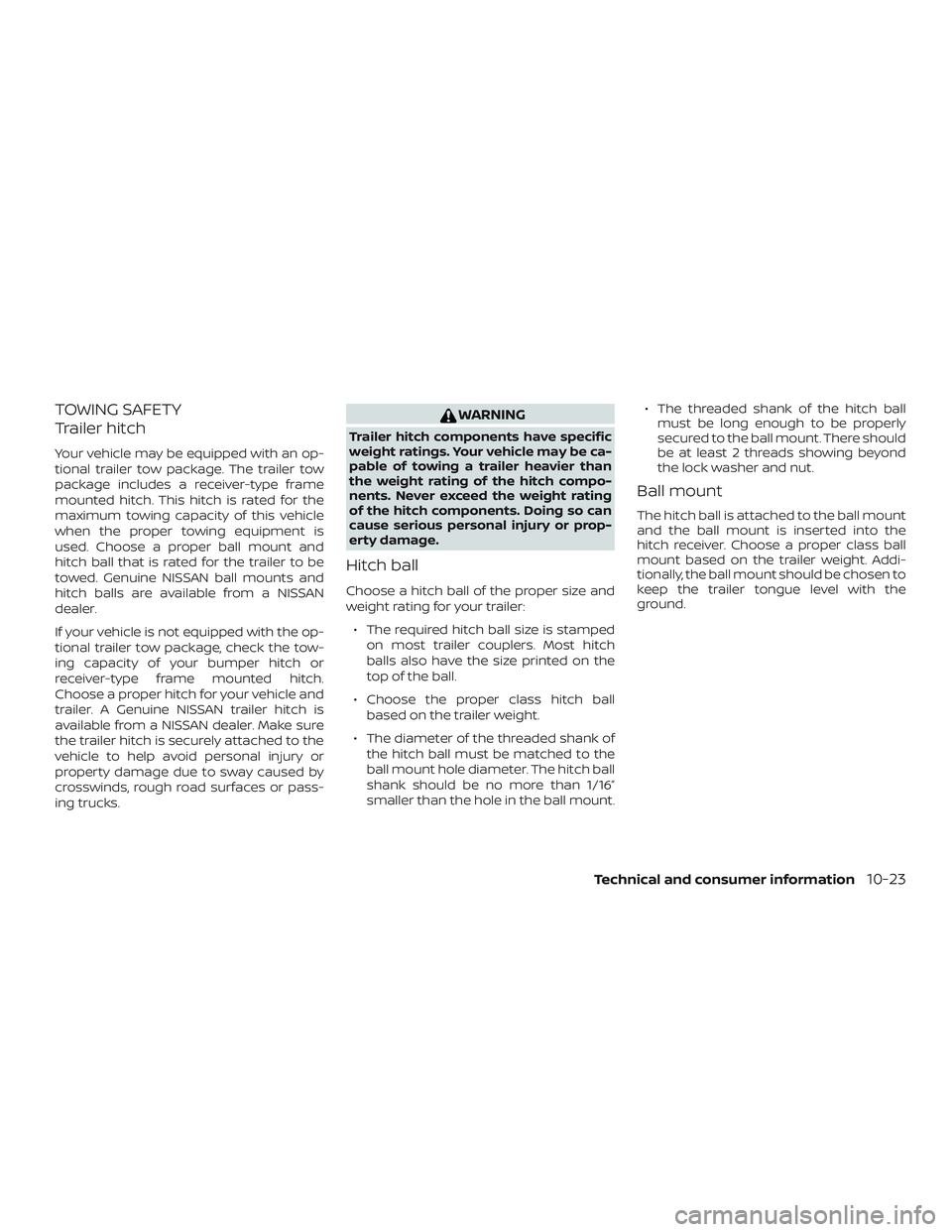
TOWING SAFETY
Trailer hitch
Your vehicle may be equipped with an op-
tional trailer tow package. The trailer tow
package includes a receiver-type frame
mounted hitch. This hitch is rated for the
maximum towing capacity of this vehicle
when the proper towing equipment is
used. Choose a proper ball mount and
hitch ball that is rated for the trailer to be
towed. Genuine NISSAN ball mounts and
hitch balls are available from a NISSAN
dealer.
If your vehicle is not equipped with the op-
tional trailer tow package, check the tow-
ing capacity of your bumper hitch or
receiver-type frame mounted hitch.
Choose a proper hitch for your vehicle and
trailer. A Genuine NISSAN trailer hitch is
available from a NISSAN dealer. Make sure
the trailer hitch is securely attached to the
vehicle to help avoid personal injury or
property damage due to sway caused by
crosswinds, rough road surfaces or pass-
ing trucks.
WARNING
Trailer hitch components have specific
weight ratings. Your vehicle may be ca-
pable of towing a trailer heavier than
the weight rating of the hitch compo-
nents. Never exceed the weight rating
of the hitch components. Doing so can
cause serious personal injury or prop-
erty damage.
Hitch ball
Choose a hitch ball of the proper size and
weight rating for your trailer:∙ The required hitch ball size is stamped on most trailer couplers. Most hitch
balls also have the size printed on the
top of the ball.
∙ Choose the proper class hitch ball based on the trailer weight.
∙ The diameter of the threaded shank of the hitch ball must be matched to the
ball mount hole diameter. The hitch ball
shank should be no more than 1/16”
smaller than the hole in the ball mount. ∙ The threaded shank of the hitch ball
must be long enough to be properly
secured to the ball mount. There should
be at least 2 threads showing beyond
the lock washer and nut.
Ball mount
The hitch ball is attached to the ball mount
and the ball mount is inserted into the
hitch receiver. Choose a proper class ball
mount based on the trailer weight. Addi-
tionally, the ball mount should be chosen to
keep the trailer tongue level with the
ground.
Technical and consumer information10-23
Page 409 of 426
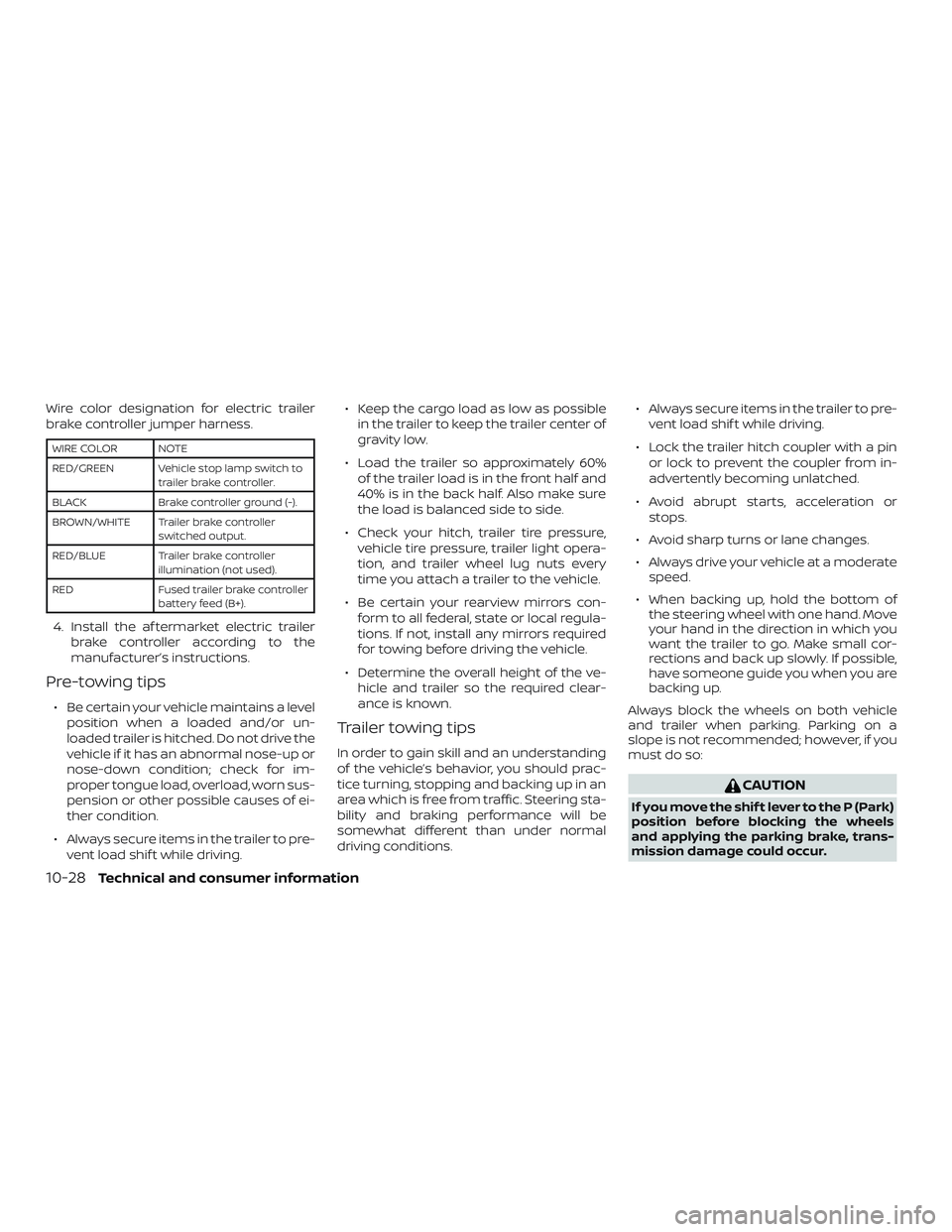
Wire color designation for electric trailer
brake controller jumper harness.
WIRE COLOR NOTE
RED/GREEN Vehicle stop lamp switch totrailer brake controller.
BLACK Brake controller ground (-).
BROWN/WHITE Trailer brake controller switched output.
RED/BLUE Trailer brake controller illumination (not used).
RED Fused trailer brake controller battery feed (B+).
4. Install the af termarket electric trailerbrake controller according to the
manufacturer’s instructions.
Pre-towing tips
∙ Be certain your vehicle maintains a levelposition when a loaded and/or un-
loaded trailer is hitched. Do not drive the
vehicle if it has an abnormal nose-up or
nose-down condition; check for im-
proper tongue load, overload, worn sus-
pension or other possible causes of ei-
ther condition.
∙ Always secure items in the trailer to pre- vent load shif t while driving. ∙ Keep the cargo load as low as possible
in the trailer to keep the trailer center of
gravity low.
∙ Load the trailer so approximately 60% of the trailer load is in the front half and
40% is in the back half. Also make sure
the load is balanced side to side.
∙ Check your hitch, trailer tire pressure, vehicle tire pressure, trailer light opera-
tion, and trailer wheel lug nuts every
time you attach a trailer to the vehicle.
∙ Be certain your rearview mirrors con- form to all federal, state or local regula-
tions. If not, install any mirrors required
for towing before driving the vehicle.
∙ Determine the overall height of the ve- hicle and trailer so the required clear-
ance is known.
Trailer towing tips
In order to gain skill and an understanding
of the vehicle’s behavior, you should prac-
tice turning, stopping and backing up in an
area which is free from traffic. Steering sta-
bility and braking performance will be
somewhat different than under normal
driving conditions. ∙ Always secure items in the trailer to pre-
vent load shif t while driving.
∙ Lock the trailer hitch coupler with a pin or lock to prevent the coupler from in-
advertently becoming unlatched.
∙ Avoid abrupt starts, acceleration or stops.
∙ Avoid sharp turns or lane changes.
∙ Always drive your vehicle at a moderate speed.
∙ When backing up, hold the bottom of the steering wheel with one hand. Move
your hand in the direction in which you
want the trailer to go. Make small cor-
rections and back up slowly. If possible,
have someone guide you when you are
backing up.
Always block the wheels on both vehicle
and trailer when parking. Parking on a
slope is not recommended; however, if you
must do so:
CAUTION
If you move the shif t lever to the P (Park)
position before blocking the wheels
and applying the parking brake, trans-
mission damage could occur.
10-28Technical and consumer information
Page 410 of 426
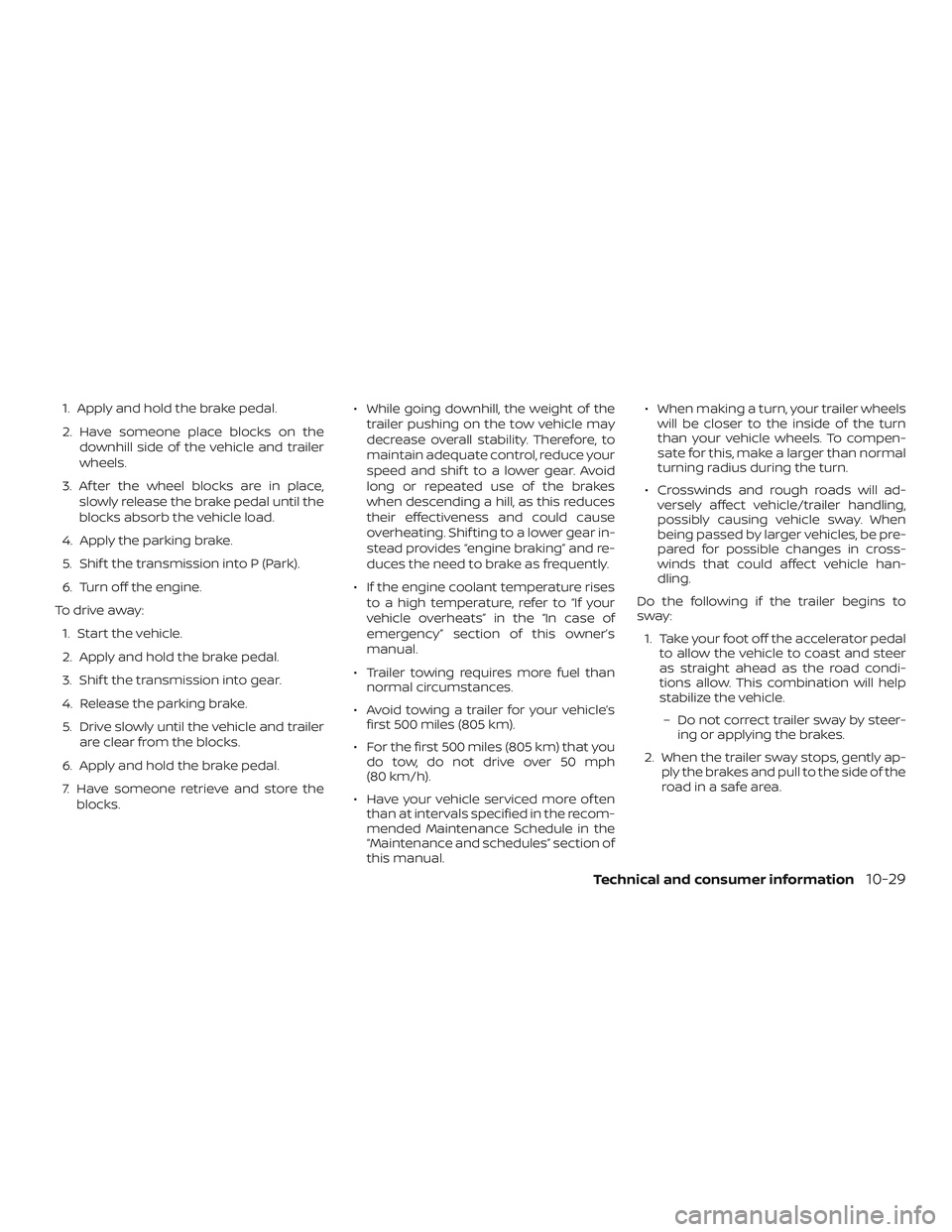
1. Apply and hold the brake pedal.
2. Have someone place blocks on thedownhill side of the vehicle and trailer
wheels.
3. Af ter the wheel blocks are in place, slowly release the brake pedal until the
blocks absorb the vehicle load.
4. Apply the parking brake.
5. Shif t the transmission into P (Park).
6. Turn off the engine.
To drive away: 1. Start the vehicle.
2. Apply and hold the brake pedal.
3. Shif t the transmission into gear.
4. Release the parking brake.
5. Drive slowly until the vehicle and trailer are clear from the blocks.
6. Apply and hold the brake pedal.
7. Have someone retrieve and store the blocks. ∙ While going downhill, the weight of the
trailer pushing on the tow vehicle may
decrease overall stability. Therefore, to
maintain adequate control, reduce your
speed and shif t to a lower gear. Avoid
long or repeated use of the brakes
when descending a hill, as this reduces
their effectiveness and could cause
overheating. Shif ting to a lower gear in-
stead provides “engine braking” and re-
duces the need to brake as frequently.
∙ If the engine coolant temperature rises to a high temperature, refer to “If your
vehicle overheats” in the “In case of
emergency” section of this owner’s
manual.
∙ Trailer towing requires more fuel than normal circumstances.
∙ Avoid towing a trailer for your vehicle’s first 500 miles (805 km).
∙ For the first 500 miles (805 km) that you do tow, do not drive over 50 mph
(80 km/h).
∙ Have your vehicle serviced more of ten than at intervals specified in the recom-
mended Maintenance Schedule in the
“Maintenance and schedules” section of
this manual. ∙ When making a turn, your trailer wheels
will be closer to the inside of the turn
than your vehicle wheels. To compen-
sate for this, make a larger than normal
turning radius during the turn.
∙ Crosswinds and rough roads will ad- versely affect vehicle/trailer handling,
possibly causing vehicle sway. When
being passed by larger vehicles, be pre-
pared for possible changes in cross-
winds that could affect vehicle han-
dling.
Do the following if the trailer begins to
sway: 1. Take your foot off the accelerator pedal to allow the vehicle to coast and steer
as straight ahead as the road condi-
tions allow. This combination will help
stabilize the vehicle.
– Do not correct trailer sway by steer- ing or applying the brakes.
2. When the trailer sway stops, gently ap- ply the brakes and pull to the side of the
road in a safe area.
Technical and consumer information10-29
Page 418 of 426
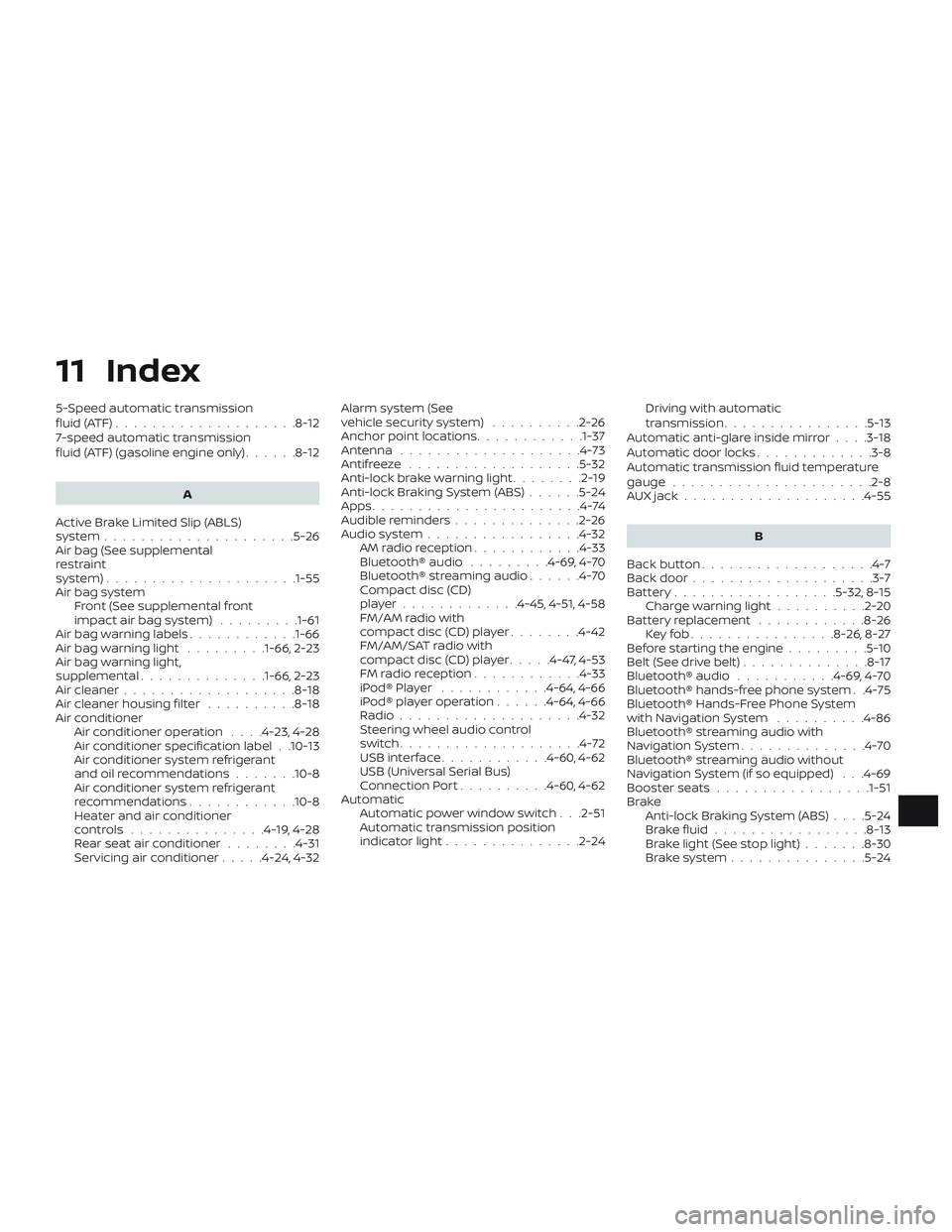
11 Index
5-Speed automatic transmission
fluid(ATF)....................8-12
7-speed automatic transmission
fluid (ATF) (gasoline engine only)......8-12
A
Active Brake Limited Slip (ABLS)
system .....................5-26
Air bag (See supplemental
restraint
system) .................... .1-55
Air bag system Front (See supplemental front
impact air bag system) .........1-61
Air bag warning labels ............1-66
Airbagwarninglight .........1-66, 2-23
Air bag warning light,
supplemental ..............1-66, 2-23
Air cleaner ...................8-18
Air cleaner housing filter ..........8-18
Air conditioner Air conditioner operation ....4-23,4-28
Air conditioner specification label . .10-13
Air conditioner system refrigerant
and oil recommendations .......10-8
Air conditioner system refrigerant
recommendations ............10-8
Heater and air conditioner
controls...............4-19,4-28
Rear seat air conditioner ........4-31
Servicing air conditioner .....4-24,4-32Alarm system (See
vehicle security system)
..........2-26
Anchor point locations ............1-37
Antenna ....................4-73
Antifreeze ...................5-32
Anti-lock brake warning light ........2-19
Anti-lock Braking System (ABS) ......5-24
Apps .......................4-74
Audible reminders ..............2-26
Audiosystem.................4-32 AMradioreception............4-33
Bluetooth® audio .........4-69,4-70
Bluetooth® streaming audio ......4-70
Compact disc (CD)
player.............4-45,4-51,4-58
FM/AM radio with
compact disc (CD) player ........4-42
FM/AM/SAT radio with
compact disc (CD) player .....4-47,4-53
FMradioreception............4-33
iPod®Player ............4-64,4-66
iPod® player operation ......4-64,4-66
Radio ....................4-32
Steering wheel audio control
switch....................4-72
USBinterface............4-60,4-62
USB (Universal Serial Bus)
Connection Port ..........4-60,4-62
Automatic Automatic power window switch . . .2-51
Automatic transmission position
indicatorlight...............2-24 Driving with automatic
transmission................5-13
Automatic anti-glare inside mirror ....3-18
Automatic door locks .............3-8
Automatic transmission fluid temperature
gauge ......................2-8
AUXjack....................4-55
B
Back button ...................4-7
Back door ....................3-7
Battery..................5-32,8-15 Charge warning light ..........2-20
Battery replacement ............8-26
Keyfob................8-26,8-27
Before starting the engine .........5-10
Belt(Seedrivebelt)..............8-17
Bluetooth® audio ...........4-69,4-70
Bluetooth® hands-free phone system . .4-75
Bluetooth® Hands-Free Phone System
withNavigationSystem ..........4-86
Bluetooth® streaming audio with
NavigationSystem..............4-70
Bluetooth® streaming audio without
Navigation System (if so equipped) . . .4-69
Booster seats .................1-51
Brake Anti-lock Braking System (ABS) ....5-24
B
rakefluid.................8-13
Brakelight(Seestoplight).......8-30
Brakesystem...............5-24
Page 419 of 426
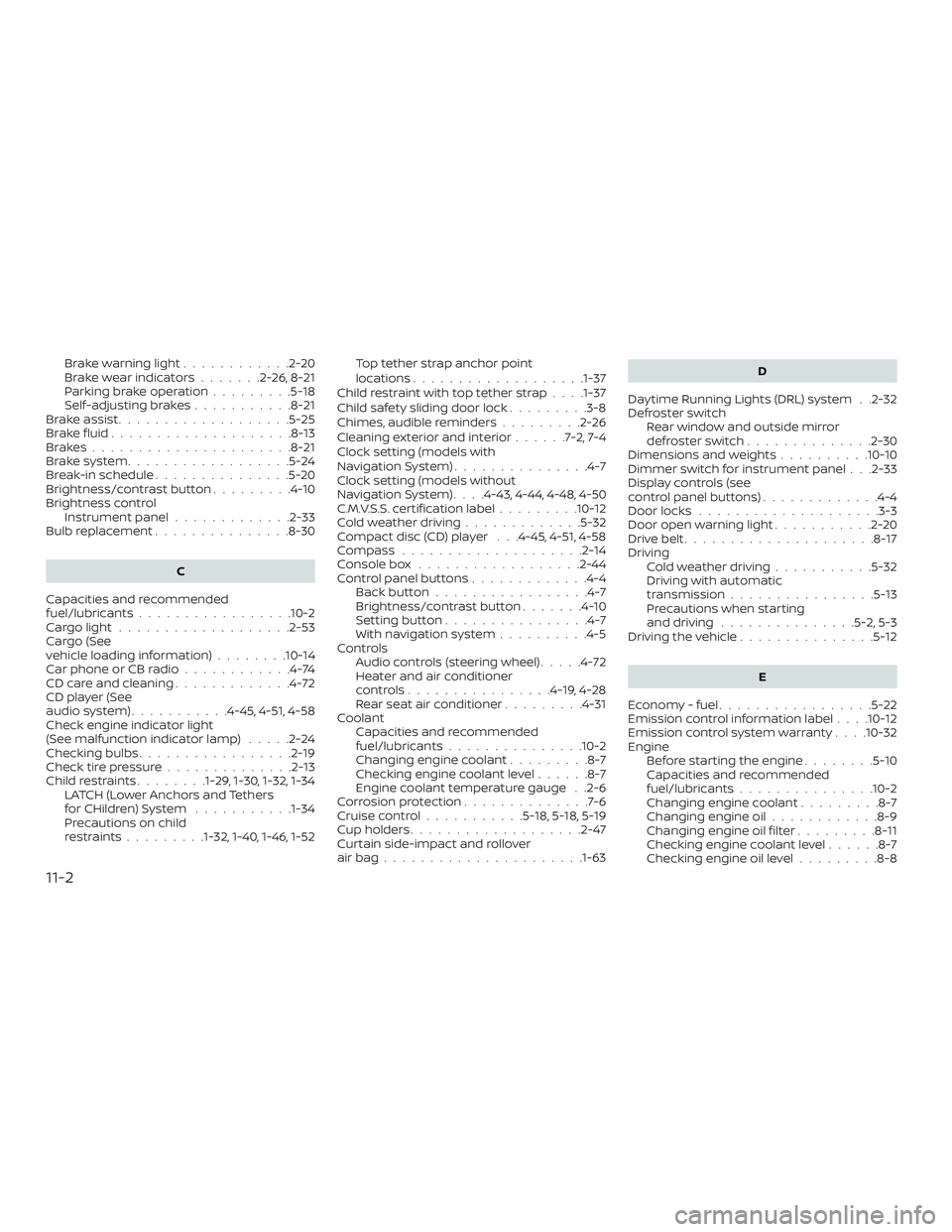
Brakewarninglight............2-20
Brakewearindicators.......2-26,8-21
Parking brake operation.........5-18
Self-adjustingbrakes...........8-21
Brake assist ...................5-25
Brakefluid....................8-13
Brakes......................8-21
Brake system ..................5-24
Break-in schedule ...............5-20
Brightness/contrast button .........4-10
Brightness control Instrument panel .............2-33
Bulb replacement ...............8-30
C
Capacities and recommended
fuel/lubricants.................10-2
Cargolight...................2-53
Cargo (See
vehicle loading information) ........10-14
Car phone or CB radio ............4-74
CDcareandcleaning.............4-72
CD player (See
audio system) ...........4-45,4-51,4-58
Check engine indicator light
(See malfunction indicator lamp) .....2-24
Checking bulbs .................2-19
Check tire pressure ..............2-13
Childrestraints........1-29, 1-30, 1-32, 1-34 LATCH (Lower Anchors and Tethers
forCHildren)System ...........1-34
Precautions on child
restraints.........1-32, 1-40, 1-46, 1-52 Top tether strap anchor point
locations..................
.1-37
Child restraint with top tether strap . . . .1-37
Child safety sliding door lock .........3-8
Chimes, audible reminders .........2-26
Cleaningexteriorandinterior......7-2,7-4
Clock setting (models with
NavigationSystem)...............4-7
Clock setting (models without
NavigationSystem)....4-43,4-44,4-48,4-50
C.M.V.S.S. certification label .........10-12
Cold weather driving .............5-32
Compact disc (CD) player . . .4-45, 4-51, 4-58
Compass ....................2-14
Console box ..................2-44
Control panel buttons .............4-4
Back button .................4-7
Brightness/contrast button .......4-10
Settingbutton................4-7
Withnavigationsystem..........4-5
Controls Audio controls (steering wheel) .....4-72
Heater and air conditioner
controls................4-19,4-28
Rear seat air conditioner .........4-31
Coolant Capacities and recommended
fuel/lubricants...............10-2
Changing engine coolant .........8-7
Checking engine coolant level ......8-7
Engine coolant temperature gauge . .2-6
Corrosionprotection..............7-6
Cruisecontrol...........5-18,5-18,5-19
Cupholders...................2-47
Curtain side-impact and rollover
airbag..................... .1-63D
Daytime Running Lights (DRL) system . .2-32
Defroster switch Rear window and outside mirror
defrosterswitch..............2-30
Dimensions and weights ..........10-10
Dimmer switch for instrument panel . . .2-33
Display controls (see
control panel buttons) .............4-4
Door locks ....................3-3
Door open warning light ...........2-20
Drivebelt.....................8-17
Driving Coldweatherdriving...........5-32
Driving with automatic
transmission ................5-13
Precautions when starting
anddriving.............. .5-2, 5-3
Driving the vehicle ...............5-12
E
Economy - fuel .................5-22
Emission control information label . . . .10-12
Emission control system warranty . . . .10-32
Engine Before starting the engine ........5-10
C
apacities and recommended
fuel/lubricants...............10-2
Changing engine coolant .........8-7
Changing engine oil ............8-9
Changing engine oil filter .........8-11
Checking engine coolant level ......8-7
Checking engine oil level .........8-8
11-2
Page 420 of 426
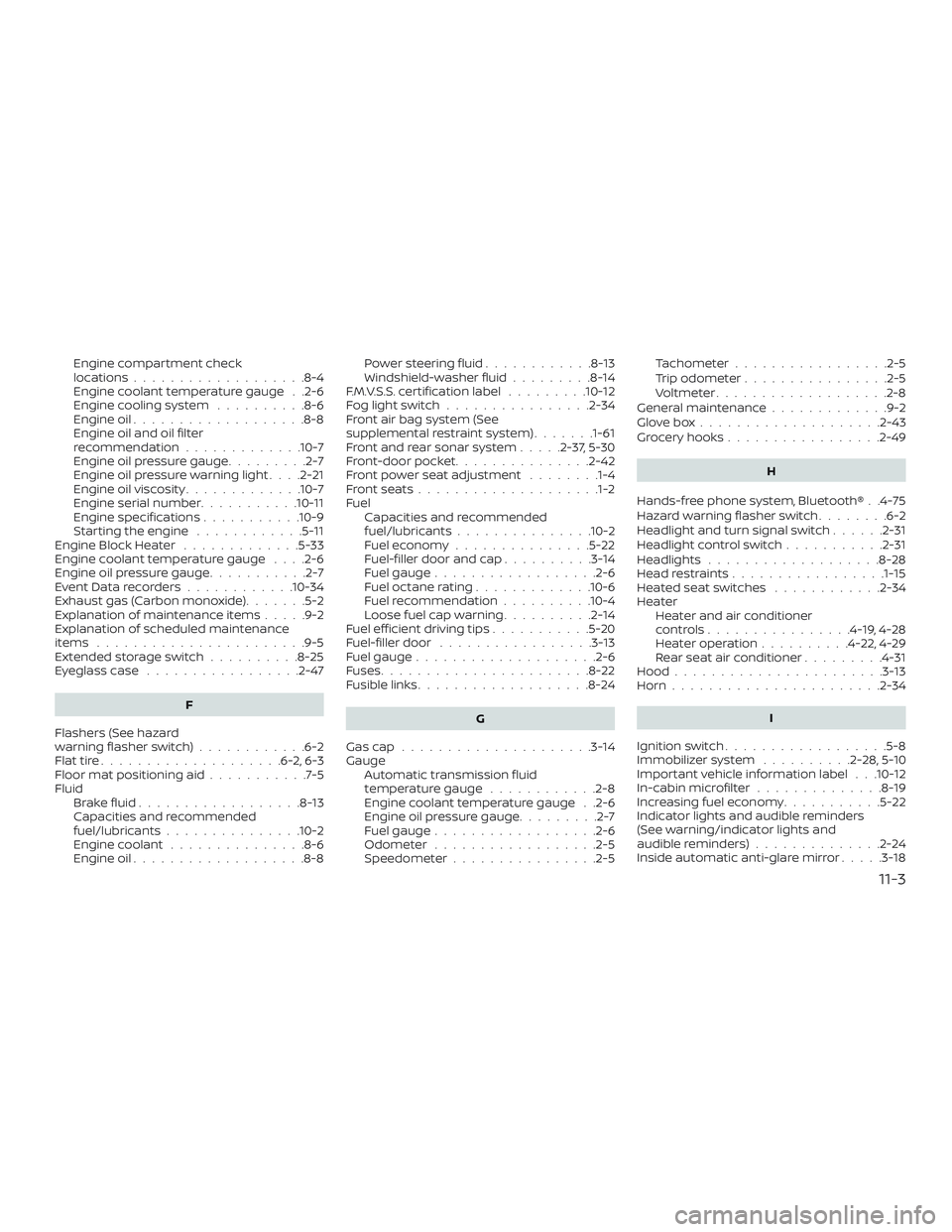
Engine compartment check
locations...................8-4
Engine coolant temperature gauge . .2-6
Engine cooling system..........8-6
Engine oil ...................8-8
Engine oil and oil filter
recommendation .............10-7
Engine oil pressure gauge .........2-7
Engine oil pressure warning light ....2-21
Engine oil viscosity .............10-7
Engine serial number ...........10-11
Engine specifications ...........10-9
Starting the engine ............5-11
Engine Block Heater .............5-33
Engine coolant temperature gauge ....2-6
Engine oil pressure gauge ...........2-7
EventDatarecorders............10-34
Exhaust gas (Carbon monoxide) .......5-2
Explanation of maintenance items .....9-2
Explanation of scheduled maintenance
items .......................9-5
Extended storage switch ..........8-25
Eyeglasscase .................2-47
F
Flashers (See hazard
warning flasher switch) ............6-2
Flattire....................6-2,6-3
Floormatpositioningaid...........7-5
Fluid Brakefluid..................8-13
Capacities and recommended
fuel/lubricants...............10-2
Engine coolant ...............8-6
Engine oil ...................8-8 Powersteeringfluid............8-13
Windshield-washer fluid
.........8-14
F.M.V.S.S. certification label .........10-12
Foglightswitch................2-34
Front air bag system (See
supplemental restraint system) .......1-61
Front and rear sonar system .....2-37,5-30
Front-door pocket ...............2-42
Front power seat adjustment ........1-4
Frontseats....................1-2
Fuel Capacities and recommended
fuel/lubricants...............10-2
Fuel economy ...............5-22
Fuel-filler door and cap ..........3-14
Fuel gauge ..................2-6
Fueloctanerating.............10-6
Fuel recommendation ..........10-4
Loose fuel cap warning ..........2-14
Fuel efficient driving tips ...........5-20
Fuel-filler door .................3-13
Fuel gauge ....................2-6
Fuses .......................8-22
Fusiblelinks...................8-24
G
Gascap .....................3-14
Gauge Automatic transmission fluid
temperature gauge ............2-8
Engine coolant temperature gauge . .2-6
Engine oil pressure gauge .........2-7
Fuel gauge ..................2-6
Odometer ..................2-5
Speedometer ................2-5 Tachometer
.................2-5
Trip odometer ................2-5
Voltmeter...................2-8
General maintenance .............9-2
Glovebox................... .2-43
Grocery hooks .................
2-49
H
Hands-free phone system, Bluetooth® . .4-75
Hazardwarningflasherswitch........6-2
Headlight and turn signal switch ......2-31
Headlightcontrolswitch...........2-31
Headlights...................8-28
Headrestraints.................1-15
Heated seat switches ............2-34
Heater Heater and air conditioner
controls................4-19,4-28
Heater operation ..........4-22,4-29
Rear seat air conditioner .........4-31
Hood .......................3-13
Horn.......................2-34
I
Ignition switch ..................5-8
Immobilizer system ..........2-28,5-10
Important vehicle information label . . .10-12
In-cabinmicrofilter ..............8-19
Increasing fuel economy ...........5-22
Indicator lights and audible reminders
(See warning/indicator lights and
audible reminders) ..............2-24
Inside automatic anti-glare mirror .....3-18
11-3
Page 421 of 426
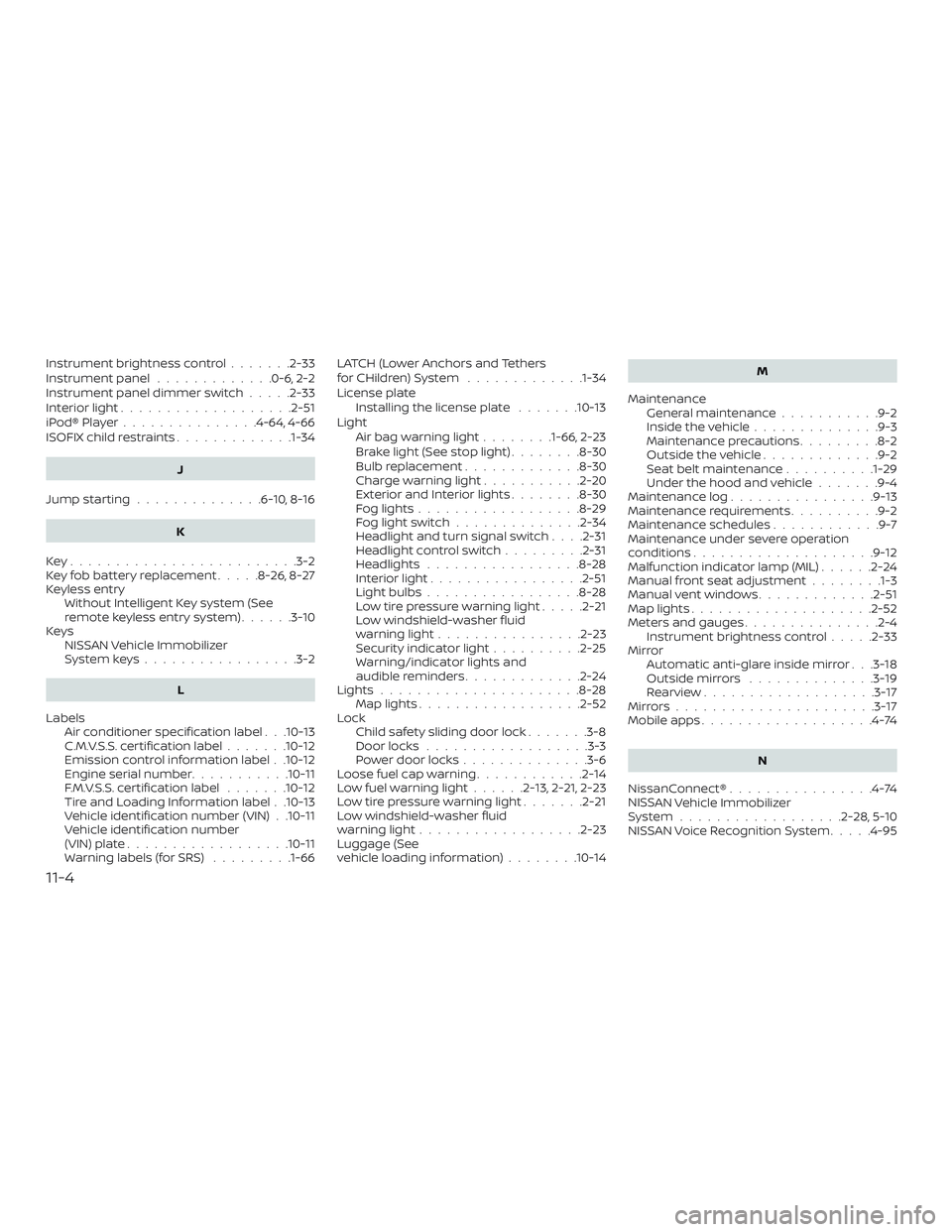
Instrument brightness control.......2-33
Instrument panel .............0-6,2-2
Instrument panel dimmer switch .....2-33
Interiorlight...................2-51
iPod®Player...............4-64,4-66
ISOFIX child restraints .............1-34
J
Jumpstarting..............6-10,8-16
K
Key.........................3-2
Key fob battery replacement .....8-26,8-27
Keyless entry Without Intelligent Key system (See
remote keyless entry system) ......3-10
Keys NISSAN Vehicle Immobilizer
Systemkeys.................3-2
L
Labels Air conditioner specification label . . .10-13
C.M.V.S.S. certification label .......10-12
Emission control information label . .10-12
Engine serial number ...........10-11
F.M.V.S.S. certification label .......10-12
Tire and Loading Information label . .10-13
Vehicle identification number (VIN) . .10-11
Vehicle identification number
(VIN)plate..................10-11
Warning labels (for SRS) .........1-66LATCH (Lower Anchors and Tethers
forCHildren)System ............
.1-34
License plate Installing the license plate .......10-13
Light Airbagwarninglight........1-66, 2-23
Brakelight(Seestoplight)........8-30
Bulb replacement .............8-30
Charge warning light ...........2-20
ExteriorandInteriorlights........8-30
Foglights..................8-29
Foglightswitch..............2-34
Headlight and turn signal switch ....2-31
Headlightcontrolswitch.........2-31
Headlights.................8-28
Interiorlight.................2-51
Lightbulbs.................8-28
Low tire pressure warning light .....2-21
Low windshield-washer fluid
warninglight................2-23
Security indicator light ..........2-25
Warning/indicator lights and
audible reminders .............2-24
Lights......................8-28 Maplights..................2-52
Lock Child safety sliding door lock .......3-8
Door locks ..................3-3
Power door locks ..............3-6
Loose fuel cap warning ............2-14
Lowfuelwarninglight......2-13,2-21,2-23
Low tire pressure warning light .......2-21
Low windshield-washer fluid
warninglight..................2-23
Luggage (See
vehicle loading information) ........10-14 M
Maintenance General maintenance ...........9-2
Insidethevehicle..............9-3
Maintenance precautions .........8-2
Outsidethevehicle.............9-2
Seat belt maintenance ..........1-29
Under the hood and vehicle .......9-4
Maintenance log ................9-13
Maintenance requirements ..........9-2
Maintenance schedules ............9-7
Maintenance under severe operation
conditions....................9-12
Malfunctionindicatorlamp(MIL)......2-24
Manual front seat adjustment ........1-3
Manual vent windows .............2-51
Maplights....................2-52
Meters and gauges ...............2-4
Instrument brightness control .....2-33
Mirror Automatic anti-glare inside mirror . . .3-18
Outsidemirrors ..............3-19
Rearview...................3-17
Mirrors......................3-17
Mobile apps ...................4-74
N
NissanConnect® ................4-74
NISS
AN Vehicle Immobilizer
System..................2-28,5-10
NISSAN Voice Recognition System .....4-95
11-4